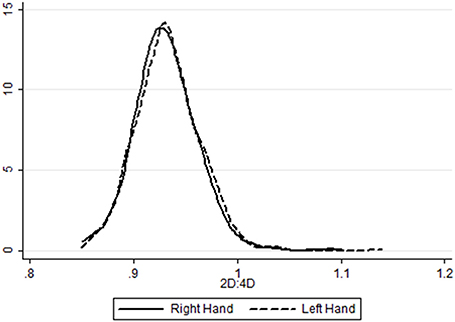

ĭigit ratio has been reported to correlate with a wide number of traits and conditions, ranging in almost every field of medicine, with particular regard to sex hormones- dependent conditions, i.e., breast cancer, prostate cancer, obesity, and osteoarthritis. This is confirmed by the observation that the 2D:4D ratio is sexually dimorphic: generally, females have a higher 2D:4D than males and this effect is more pronounced in the right hands, although the reasons still need to be clarified. In fact, males are exposed to higher levels of testosterone than females, particularly from about week 8 to 24 of gestation and week 2 to 26 of postnatal life. Prenatal hormone exposure is critical for sexual differentiation and masculinization. In humans, the 2D:4D ratio has been assumed to reflect the exposure to testosterone during the second trimester of gestation, because of the sex difference detectable in childhood, and because of postulated mechanisms regarding digit development. More evidence is provided by molecular genetic association studies, relating a polymorphism of the androgen receptor gene to individual differences in the 2D:4D ratio. Many debates exist around the reasons why 2D:4D could be considered an indirect marker of the prenatal, but not the present, testosterone level and even more strongly, a marker of the ratio between prenatal testosterone and estradiol levels. 2D:4D is constant throughout life and represents an indirect, retrospective, and non-invasive measure that correlates negatively with intrauterine exposure to testosterone, i.e., a lower 2D:4D is the result of increased levels of fetal testosterone. The second-to-fourth digit ratio (2D:4D) is a biological marker, defined as the ratio of the length of the index (second digit) to the length of the ring finger (fourth digit) of the same hand. Keywords: Meta-analysis Mental disorders Testosterone Autism spectrum disorder Attention deficit disorder with hyperactivity Substance addiction Although our results need to be cautiously interpreted and find limited applications in clinical practice, they may suggest that 2D:4D is altered in some psychopathological conditions, underlining the role of prenatal exposure to sex steroids in the etiology of psychiatric disorders. No other significant differences were detected. Conversely, the right hand of males with schizophrenia showed higher 2D:4D than healthy controls. Considering psychiatric disorders individually, significant differences were found in the ASD, ADHD, and addictions groups, in which 2D:4D was significantly lower than healthy controls. Meta-analyses showed that, overall, psychiatric patients had lower 2D:4D than healthy controls (n = 43, overall sample = 9,484, mean difference = −0.0056, 95% confidence interval from −0.0093 to −0.002, I 2 = 74%), with more pronounced differences in the right hand, males, and children. We finally included 43 case-control studies which compared the 2D:4D ratio of patients with autism spectrum disorder (ASD) (n = 16), schizophrenia (n = 8), gender non-conformity (n = 7), addictions (n = 5), attention deficit-hyperactivity disorder (ADHD) (n = 4), mood disorders (n = 2), and intellectual disability (n = 1) to non-clinical controls. In September 2019, we searched in Web of Knowledge, PsycINFO, Embase, and CINHAL, and retrieved 619 papers. The present meta-analysis aimed to evaluate if 2D:4D differs between patients with psychiatric disorders and controls. Abstract The second-to-fourth digit ratio (2D:4D) is an indirect, retrospective, non-invasive measure that correlates negatively with intrauterine exposure to testosterone.


 0 kommentar(er)
0 kommentar(er)
